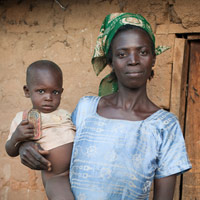
Total Awarded: $22,814,760
Duration: 1990 - 2013
Total Grants: 456
Geographic Focus: Brazil, India, Mexico, Nigeria
Background
The Fund for Leadership Development (FLD) was an initiative of MacArthur's Population and Reproductive Health (PRH) program that was implemented from the early 1990s until 2013. The purpose of the FLD was to foster new leadership in, and contributions to, the PRH field in four countries: Brazil, Mexico, Nigeria, and India. It was designed in response to the lack of broad and flexible support for innovative individuals working on complex PRH issues. Starting from the assumption that countries' population problems were better addressed when priority was given to local leaders and institutions, the FLD sought to enhance personal and professional development of those leaders, and to promote opportunities for them to make lasting contributions to the PRH field. In each country, the FLD staff relied on the support of National Selection Committees to select mid-career individuals, aged 25-45, who had demonstrated the potential to make significant contributions to the PRH field. Mentors, who were more senior in the PRH field than the grantees, were also recruited to provide guidance throughout the grant cycle (1-3 years). The FLD was directly implemented by the Foundation's country offices in the first ten years of its history. Management was then transitioned to local organizations with expertise on PRH issues: CEBRAP/CCR in Brazil (2003 – 2008), Semillas in Mexico (2002 – 2013), Pathfinder International in Nigeria (2004 – 2008) and Population Council in India (2004 – 2008). Over the course of its implementation, FLD awarded more than 400 grants to young and mid-career professionals who shared a commitment to promoting positive change in their work.
What We Evaluated
In May 2016, the Foundation commissioned the Institute of International Education (IIE) to conduct a retrospective evaluation of the FLD. The purpose of the retrospective evaluation was to:
- Evaluate the extent to which the FLD achieved its overarching goals and mission
- Assess program implementation through grantee selection, implementation, and management processes
- Identify best practices and strategies that worked in the FLD program, with recommendations for future programs aimed to address similar issues.
What We Learned
- Data revealed that leadership development occurred in all countries, and many examples provide evidence that organizations, local communities, and grantees' countries all benefited from FLD grantees' activities during and after their program participation. Some grantees reported that FLD's unique approach to leadership development had a considerable effect on their career; in supporting what other donors would not, FLD was a groundbreaking opportunity for those willing to take initiative. Grantees also influenced the knowledge and practice in and beyond the PRH field and improved the rights and access of marginalized groups to reproductive health services locally, nationally, and internationally.
- The Foundation country offices and partner organizations defined selection criteria to allow committee members to look for emerging leaders, beyond the obvious stars. The process was flexible in its selection of projects to allow for innovation and risk-taking. The Foundation saw selecting grantees from multiple backgrounds as important because similar programs at that time focused on only candidates from the same background.
- Managing a program such as FLD required a dedicated and large team for follow-up, information dissemination, networking facilitation, capacity-building, and day-to-day support. The program team required skills in program management, leadership development, capacity-building, thematic subject area expertise, and financial management. According to some stakeholders, the FLD day-to-day support was not sufficient in some instances.
- In developing countries, organizations and individuals often face the challenge of access to sources of funding. Providing funding to individuals made FLD a unique program. More than 90 percent of survey respondents indicated that this financial support was "very useful." When the program changed this element, such as with the Emerging Leaders Development Program in Nigeria, and provided resources and training rather than the financial awards, key stakeholders noted that the outcomes were not as impactful.
- Flexibility was key to the design of FLD, and over years, program staff regularly sought stakeholders' feedback to better structure program activities. In Mexico, for example, the program staff introduced grantees' self-evaluation to tailor support to grantees' needs.
- The broader thematic focus and flexibility of the program in initial years allowed for more applications and innovation. The narrowing of the thematic focus and subsequent research focus led to a reduction in applications in India and Nigeria.
- Partner organizations with prior involvement in or knowledge of FLD allowed for a smoother transition of the program from the Foundation. The most successful transitions were gradual and allowed sufficient time for the new organization to gain a solid understanding of the program prior to assuming full management responsibility.
- FLD attempted to bring together grantees through networking during annual meetings, workshops, and seminars. These efforts helped develop a feeling of community and were important in building synergies. However, grantees mentioned that FLD fell short of building and fostering an alumni network over the long-term. Many expressed disappointment that there was no networking platform for alumni.



